The typical EV costs about 40 percent more than an otherwise comparable vehicle with an engine. Plus, it costs a lot more (about $50,000 on average) regardless. So it’s hard to make an economic case for an EV.
Or a practical one – given that the typical EV can only travel about 250 miles before it runs out of charge – and requires you to stop and wait for at least 20-30 minutes to recover a partial charge.
But it’s much easier to make a case for the hybrid Corolla. It only costs about $1,450 more than an otherwise identical (just non-hybrid) Corolla and it doesn’t cost much, regardless – just $23,500 to start or about half the cost of a typical new EV.
You also get a lot for the not-much-extra you pay.
How’s about 20 miles-per-gallon better gas mileage than you get with the non-hybrid Corolla sound?
Pretty good, right?
What It Is
The Corolla is Toyota’s entry level sedan and one of the best selling cars ever made. Probably in part because even though it’s a compact-sized car on the outside, it’s spacious enough inside to work as a small family car and not just a commuter car. It also has a long-established track record for reliability and durability.
The hybrid version adds 53 miles-per-gallon (in city driving) to the mix, for only about $1,500 more to start for the base LE trim ($23,500) than you’d pay for the essentially-the-same non-hybrid version of the Corolla ($22,050).
The $25,940 hybrid Corolla SE also only costs $1,450 more than the otherwise-the-same non-hybrid SE ($24,490).
Same goes for the Nightshade trim. There’s only a $1,450 difference in price between the hybrid version ($26,940) and the non-hybrid version ($25,490).
And there’s almost no difference between the price of the top-of-the-line XLE hybrid ($27,250) and the non-hybrid version of the same thing ($27,150).
What’s New For 2024
The Nightshade trim returns for the new model year; this version of the Corolla hybrid gets unique black body cladding and rear spoiler, along with a special bronze-anodized 18 inch wheel package specific to this trim.
What’s Good
Twice the range (almost 600 miles in city driving) of most EVs for less than half the cost of the typical EV.
Fill up the tank in less than five minutes – as opposed to waiting 20-30 minutes to get a partial charge.
Roomy enough to be feasible as a primary family car.
What’s Not So Good
There’s no spare tire (not even a temporary use “mini” spare). Instead, you get an inflator kit that can repair punctures in the tread – but not damage to the sidewall.
Top-of-the-line XLE is front-drive only.
The hybrid Corolla has a smaller (1.8 liter) four cylinder engine relative to the larger (2.0) liter engine that’s standard in the non-hybrid Corolla. The latter’s engine makes 169 horsepower and does all the work of propelling the non-hybrid Corolla, which is why the mileage of the latter (32 city, 41 highway) while very good isn’t as spectacular as the 53 city, 46 highway touted by the hybrid.
And the reason it’s so spectacular isn’t due primarily to the fact that the 1.8 liter engine is smaller or that it makes less power (136 horsepower) but rather because it only has to do some of the work of propelling the hybrid Corolla. Much of the rest is done by the hybrid’s electric motors, which are powered by a battery pack that is kept charged up by the engine (when it’s running) and by recovering some of the kinetic energy of the moving Corolla during deceleration and braking.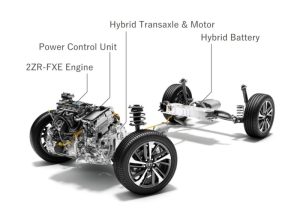
And that’s why the hybrid goes 20-plus miles farther down the road on a gallon of gasoline in city driving – which is where the hybrid system is most efficient. There’s also a 5 MPG gain on the highway, which isn’t insignificant, especially when considered in the context of the hybrid’s only slightly higher base price vs. the non-hybrid Corolla. And unless you do all – or most – of your driving on the highway, your overall MPG gain will likely be much higher – which will quickly amortize the slightly higher MSRP of the hybrid.
There’s another gain to consider, too.
The hybrid Corolla can go just shy of 600 miles on a tank, which is twice as far as the typical EV can go before it runs out of charge and obliges you to wait while it recharges. Since the Corolla hybrid recharges itself, your wait is the two or three minutes it takes to pump 11 gallons into the tank.
And unlike the typical EV’s advertised range – which very often turns out to be 20 percent less-than-advertised – the Corolla hybrid really does go as far as advertised. In part because it is much less negatively affected by how cold it is outside – because its engine produces heat to warm the cabin, which has zero effect on range.
Something else that’s different about the hybrid Corolla is that it’s available with all-wheel-drive. The non-hybrid is front-drive-only. There is a slight MPG penalty to be paid – the AWD hybrid’s mileage dips to 51 city, 44 highway – due to the additional weight of the additional motor that is used to power the rear wheels and the power that’s burned turning the rear wheels.
Both iterations of the Corolla – the hybrid and the non-hybrid – come standard with a continuously variable (CVT) automatic transmission to drive their front wheels. Toyota’s CVTs use a pinion-type starter gear to get you rolling, which greatly reduced the premature wear/tear issues with other-brand CVTs that use an expanding belt/band only.
One of the best things about driving the Corolla hybrid is not having to think about how far you can’t drive it. And how soon – and long – you’ll need to wait to be able to drive it again.
As opposed to what it’s like to drive an EV – which forces you to think about it obsessively, continuously. Chiefly because of the wait – to recharge – which can make a mess of your plans, if you didn’t plan to drive farther than you expected to need to drive – and now you’ll need to plan around how far the EV can go before it can’t go any farther.
That can really upset your plans. As well as your life.
The Corolla hybrid just goes – along with your plans and generally. Six hundred miles of city driving range (and more than 500 miles of highway driving range) equate to not having to plan around how far you can’t go. This Toyota does everything an EV doesn’t – and for about half the price.
Except for going very quickly – the one thing you relentlessly hear EVs do adeptly. And that’s true – about EVs being quick when it comes to acceleration. But you pay dearly if you use that capability much, because it takes power to accelerate quickly and – in an EV – that power is the charge stored in the battery, which is quickly depleted by acceleration because it burns a lot of energy to move a heavy EV from a dead stop to 60 in three or four seconds.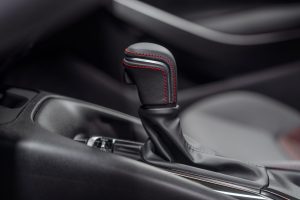
So you can’t have your cake and eat it, too.
Besides, the hybrid Corolla is quicker than a Prius used to be (the recently updated Prius is now quicker than some V8 muscle cars used to be). The FWD version can get to 60 in about 9.6 seconds – which is about a second quicker than the last-generation Prius – and it’s only slow in a pedal-to-the-metal stoplight drag race. Most cars – including “ludicrous speed” electric cars – accelerate tepidly when the light turns green. Odds are you’ll beat the EV next to you to the next red light – if you want to do that.
If, on the other hand, you just want to have enough power available to get from A to B with the flow of traffic – without feeling as though the car is always struggling to catch up – then you’ll find the hybrid Corolla is quick enough.
It is also more than pleasant enough.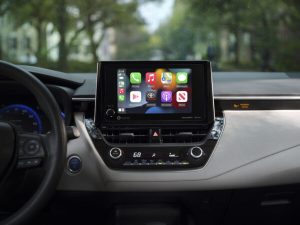
The Corolla – hybrid or not – is an easygoing, no-hassles car that makes driving it . . . pleasant. Part of this flows from its controls, which are not overteched for the sake of being overteched. There’s a grab-handle gear selector; you move it forward and back – fromPark to Drive – and that’s all there is to it. There’s an analog speedometer and tach and nothing much to distract from that. There is a secondary LCD touchscreen, but there are also redundant knob-and-button controls to make adjust the temperature, fan speed and volume control for the stereo.
There’s a reason why this car is the best-selling car ever made, by any car company. Get behind the wheel and see for yourself.
By the numbers, the Corolla (hybrid and not) is a compact-sized sedan. It is 182.5 inches long. But don’t go by the numbers.
At least, don’t go by that number.
The numbers that matter more are inside.
The driver and front seat passenger have 42 inches of legroom, which is almost exactly as much front seat legroom as the mid-sized (192.1 inches, end to end) Camry sedan, which 42.1 inches of front seat legroom. The Camry does have more backseat legroom (38 inches) but the Corolla has enough backseat legroom (34.8 inches) to accommodate adult passengers and more-than-enough to accommodate kids and teens. This makes the Corolla – which is several thousand dollars less expensive than a Camry – a viable, more affordable family car.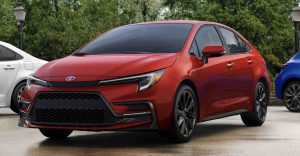
Even the trunk is only slightly less roomy than the Camry’s – 13.1 cubic feet vs. 15 for its mid-sized sibling.
There is also the Corolla’s unassuming looks to consider. Toyota has always taken care to style this car conservatively, so that it ages gracefully. This year’s Corolla doesn’t look that much different from a ten-year-old Corolla and that helps retain value, as people tend to not want to drive a car that looks old quickly – due to frequent and radical restyling.
Something else to consider is the built-in sensibility that has long defined the Corolla. Fo example, the car still comes standard with steel wheels. Aluminum wheels have their virtues – including lightness and including that aluminum can be cast in an almost limitless variety of designs. But aluminum is also more easily damaged; and aluminum wheels cost a lot more to replace than steel wheels.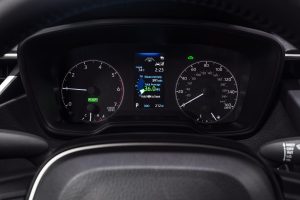
Here’s another: The Corolla has manual-adjust (rather than power adjust) seats. These adjust the seat – forward and back as well as up and down – just as quickly as electric/push-button adjust and are much less likely to ever need repair, being mechanical rather than electro-mechanical mechanisms.
One more: The dash isn’t digital and so won’t “glitch.” It just works. Like the rest of this car.
The Rest
Finding anything to nitpick about this car is not easy to do. You have to really look. And pop the trunk.
What you won’t find there is a spare tire. Not even a “mini” spare – one of those temporary-use-only things that will at least let you limp on down the road to a tire shop. Instead, Toyota provides an inflator/repair kit. This takes up much less space under the trunk floor than a spare and jacking equipment – and it will get you back on the road again without getting your hands (and clothes) dirty if you get a flat because you ran over a nail or something like that.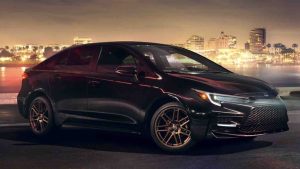
The provided goop will seal the puncture and the mini air compressor (which plugs into the cigarette lighter) will re-inflate the tire. But if the sidewall got punctured, the kit is useless – and you will have to call for a tow/roadside assistance.
The Bottom Line
The Corolla hybrid begs the question more people ought to be answering, which is why would anyone want to drive an EV when they could drive something like this, instead?
. . .
If you like what you’ve found here please consider supporting EPautos.
We depend on you to keep the wheels turning!
Our donate button is here.
If you prefer not to use PayPal, our mailing address is:
EPautos
721 Hummingbird Lane SE
Copper Hill, VA 24079
PS: Get an EPautos magnet or sticker or coaster in return for a $20 or more one-time donation or a $10 or more monthly recurring donation. (Please be sure to tell us you want a magnet or sticker or coaster – and also, provide an address, so we know where to mail the thing!)
If you like items like the Baaaaaa! baseball cap pictured below, you can find that and more at the EPautos store!



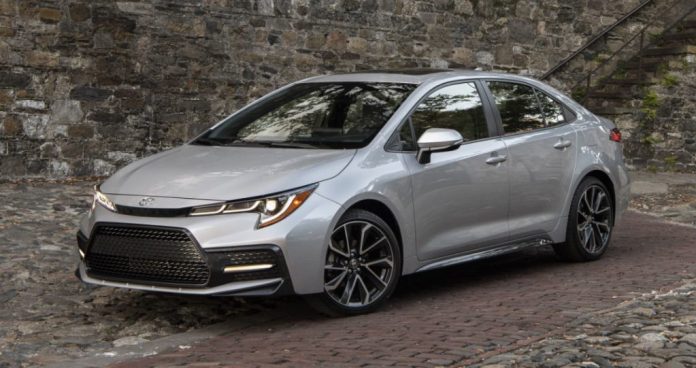

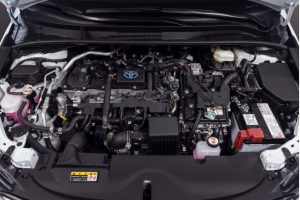
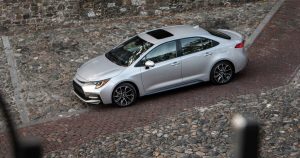
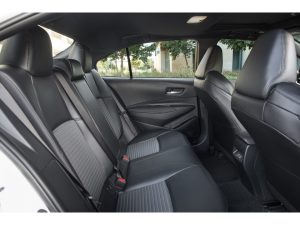







Just wanted to comment regarding Toyota’s CVT transmissions as there always tends to be some confusion when they get brought up. They have two types. As far as I know, their eCVT is what comes on most all of their hybrids (minus some of the higher-end hybrid trims on some of their newer offerings like the Crown and Grand Highlander which uses the new Direct Shift-6AT 6-speed automatic transmission which is an entirely different thing and not at all a CVT, based on my limited research anyway). Their eCVT is an electronically-controlled single planetary gear set (think fancy differential).
Their gas models get the more traditional CVT that most people think of when they hear CVT albeit with the smart addition of the launch gear that Eric mentioned (think belts and cones). Their eCVT’s are not plagued with the problems that traditional CVT’s have (although if I had to I’d still take Toyota’s traditional CVT over other manufacturer’s version). Toyota’s eCVT’s are tried-and-true and fantastic.
eCVT is a bit of a misnomer I suppose and they really should have given it a better name. But to be fair they didn’t at the time know that Nissan would forever tarnish the acronym of CVT. Ford also uses a similar eCVT in the Maverick.
Good little video demonstrating how an eCVT transmission works https://www.youtube.com/watch?v=jofycaXByTc
Prius and Corolla GR are built in Japan so are better…..
The other Corollas are not…. so are worse….
Don’t buy AWD……
A FWD car with snow tires is better then an AWD car without snow tires….
On an AWD car if one tire has to be replaced…do to damage or whatever…..you have to replace all of them…big $$$$…all the tires have to be exactly the same size and wear, or it will damage the car…..
@ 7:44 in video AWD tires
https://www.youtube.com/watch?v=xQFD3-jKokQ
Don’t buy a car with CVT transmission…..
Toyota and other manufacturers are getting cheap, selling you a car with a CVT transmission….now you get a crappier transmission…..they are ruining all the cars…
the old automatics are more expensive….pay more now…get less…
another reason….the CVT gets a bit better fuel economy…….
but…CVT’s don’t last as long…..
and they are not as responsive….an automatic with 6, 8 or 10 gears is more responsive…when you push on the gas pedal it downshifts and accelerates instantly….a CVT doesn’t…. it is more sluggish….
a bit better fuel economy…….but a sluggish car…they ruined all the cars…..
A standard transmission is best…they will last longer then a CVT or an automatic…and you are in control….
the new automatics are shifting up and down like crazy….wearing them out….
with a manual transmission….. in some cars with a 5 speed…you can drive in the city in 3rd gear and above 55 mph in 5th gear…very little shifting……plus you get engine braking saving your brakes….
https://www.youtube.com/watch?v=xQFD3-jKokQ
CVT’s are not as responsive….
So you will get to hate driving the car….that is the point…make people hate cars…they made them too good in old days…so people fell in love with them….go and drive one of the old, great driver’s cars….you will see….
unless you are an old granny. who hates cars and doesn’t mind a slow/sluggish car.
CVT is a disappointment, but today a hybrid is the best solution for those who are trying to squeeze every mile out of a gallon.
Just hope the hybrid will live up to the reputation of Corolla. Judging by the number of old Priuses out there, it will.
I’m rooting for Toyota to win the EV vs hybrid wars and thereby saving us all from this insanity.
“a hybrid is the best solution for those who are trying to squeeze every mile out of a gallon.”
Diesel was the best solution…so they had to ban them….
Used to be. They ruined diesels too.
I owned a 1983 Chevrolet Impala for a work car, wasn’t the greatest of cars but it didn’t have many problems, sold fast when I went to sell.
One day, the Impala had a flat tire on a country road leading to my Uncle’s farm. Discovered the spare was flat, you improvise. I was about five miles away limping along at 5 mph until I drove into the farmyard. Didn’t hurt the steel wheel, fixed the flat using the spare tire.
A humbling experience, sometimes, I really am dumber than I look. I was still a greenhorn, just a kid, what did I know?
If you are in the right place, you can probably make it to a tire service by driving slow.
Road side assistance is there for a reason. You need help, the flat tire is ruined.
A half inch bolt 2 inches long ended up in one of my brand new tires, it was flat and no fixing it, buy a new tire. You’re stuck, you have to change to the spare tire.
This post-modern super-advanced civilization could use some adjustment. The reflection in the big pond isn’t all that pretty these days.
If I buy this car, can I order an extra spare tire at the dealer?
Hi Bryce,
Yes, of course. I myself would just got to a salvage yard and buy a mini spare (or full-size spare) from a junked Corolla. Much less expensive that way!
Toyota sold 11.2 million vehicles in 2023. Toyota hybrids have to be a big seller. Toyota is a success story, can’t argue with success. The EPA Jackboot looms though.
One of my daughters has a Rav4 hybrid. It makes zero noise when the electric mode is on, put it in drive and you go.
The price of a share is 90 dollars more than Tesla’s.
One share of Berkshire Hathaway is topping out at 617,284 USD today.
Berkshire has an automotive group, too. The BNSF has to haul freight by the ton, that pays too.
Berkshire very much sees its future in EVs if for no other reason than it furthers Capo Gecko’s goal of being more involved with the Texas electric system.
“There’s no spare tire (not even a temporary use “mini” spare). Instead, you get an inflator kit that can repair punctures in the tread – but not damage to the sidewall.”
Do any new cars or trucks come with a spare tire? My 24-year-old Sierra has one. As part of my routine maintenance, I crawl under & check the condition & pressure of the spare. In just over four decades of driving, I’ve used a spare tire exactly twice. Thank God GM had the sense to include it.
2024 Corolla…another car that rats you out….
You don’t want all this surveillance and control crap…..
All this crap fights you when you drive….
Safety
Lane Tracing Assist (LTA)
Electronic Stability Control (ESC)
ABS And Driveline Traction Control
Side Impact Beams
Dual Stage Driver And Passenger Seat-Mounted Side Airbags
Safety Connect (up to 10-year trial subscription) Emergency Sos
Pre-Collision System (PCS)
Lane Departure Alert (LDA) w/Steering Assist Lane Keeping Assist
Lane Departure Alert (LDA) w/Steering Assist Lane Departure Warning
Collision Mitigation-Front
Driver Monitoring-Alert
Evasion Assist
Low Tire Pressure Warning
Dual Stage Driver And Passenger Front Airbags
Curtain 1st And 2nd Row Airbags
Airbag Occupancy Sensor
Driver Knee Airbag, Rear Side-Impact Airbag and Passenger Cushion Front Airbag
Are U shitting me? You know, I was going to ask Eric the following: Ok Eric, here’s a challenge for you. If you had to choose between two cars that I might consider purchasing, which one would it be: the Corolla Hybrid you just reviewed or the Toyota Prius you evaluated back in August? And just as important, why?
Now, I realize all new cars are infested with some of these insane safety devices/detectors that could drive people batty, but I had no idea they were that polluted for God’s sake!! So in that case, fuhgettaboutit.
Hi Dave,
Let me preface this by saying this is my subjective take. You asked which of the two would I pick. I’d pick the Corolla – because it’s several thousand dollars less expensive and I don’t really care that the new Prius is quicker. I’d be purchasing the car because it’s inexpensive to operate and to buy. The Prius is inexpensive to operate – but you pay a price for the performance it delivers. Not that there is anything wrong with that; indeed, there’s a lot that’s good. The Prius is about as quick to 60 as most stock V8 muscle cars of the ’70s – and gets three times their gas mileage, easily.
But for transportation appliance purposes, it is hard to beat a Corolla hybrid.
Thanks for the comment Eric. I really liked the new Prius body style and interior when I first saw it, very sexy, but now that I’ve seen a few of them running around town, that initial appeal has lessened. OTOH, the Corolla hasn’t changed much and is, well, kind of boring. Aside from the new Prius, Toyota styling has gone downhill quite a bit. I’ve always liked the looks of the Camry but the new ones are downright butt ugly.
Re: all that safety crap….
The 1960’s Fiat 500 cost $700…$7000 in 2024 dollars….weighed 1100 lb….
The Corolla costs $23,500 and weighs 3000 lb….is way too expensive for an economy car…..
Maybe half that $23,500 and 3000 lb…is for all the safety/surveillance crap….lol….you pay for it so they can watch/control you….
CeeVeeTee transmission…..no go right there….maybe at 100,000 miles…then get rid of it….it won’t last 300,000 miles like a stick shift trans.
hybrid…added weight and expense…and expensive battery to replace down the road…..these cars won’t run when the battery is dead….
The new camry is ruined too….CeeVeeTee transmission….and hybrid only….
hybrid…added weight and expense…diesel was far better….Euro VW Golfs getting 78 mpg….
3000 lb….another way overweight car….
In the 1960’s they built better cars…..The Fiat 500 weighed 1100 lb, carried 4 people…stick shift….no computers….got up to 50 mpg…cost $700…$7000 in 2024 dollars…one just sold on BAT for $16,000…because they are good….it also has the cool air cooled sound…like an old air cooled 911…rear engined too….a miniature 911…..the corolla…dead…no sound…an appliance…
The 1960’s Fiat 500 cost $700…$7000 in 2024 dollars…..at $23,500 the Corolla is way too expensive for an economy car…..
The 1960’s fiat 500 had a nice clean design….
this 2024 Corolla is a hideous design…but…all cars are designed for the Chinese market now….so this is what you are stuck with today….
Civic and Mazda 3 still have a stick shift…stick shift driver’s won’t buy the corolla….
Hi Anon,
The Corolla GR does offer a stick, I think!
Haha!
Nifty little thing. 300hp out of a 1.6 l engine! And yes, available with a manual. $36 to $45K, though, whoa.
Thanks for the review, Eric.
Right….buy the GR race car and you can shift gears….6 speed only available…no automatic…good….
one problem with it though is….Curb Weight: 3269 lb…
but…the 911 weighs the same and is supposed to be a sports car…now just a GT car….911 was ruined too…
Toyota…
First Character of VIN Origin
1, 4, 5 Made in the USA
2 Made in Canada
3 Made in Mexico
6 Made in Australia
7 Made in New Zealand
8 or 9 Made in South America
Prius is still made in Japan…
Japanese made Corollas were better….
Handbuilt at the TGR Motomachi factory in Japan, GR Corolla will set your pulse racing, and take your breath away….better quality…..better investment…and stick shift…more fun too….
Bought a new Corolla Cross AWD Hybrid for the eldest daughter, using it now for a few months to commute to work. I have to say, on roads dominated by aggressive drivers of Cinderella trucks, upside-down mortgage electric appliances, and leased German status symbols, the Cross is a breath of fresh air.
It really makes you feel like the only sane person on the road.
The Cross is not as much of a Corolla as it is a Mazda CX-50, built in the same factory in Alabama.
Yeah, about that:
https://youtu.be/9hh8Rdttowc?si=7TcpmvCAJe42iDvl
‘The hybrid version adds 53 miles-per-gallon (in city driving) to the mix, for only about $1,500 more.’ — eric
Outstanding … as an engineering feat.
Too bad about its bulging center-dash Clownscreen carbuncle, with its brightly-colored Fisher-Price icons to delight toddlers (ages 1-3).
And its CeeVeeTee transmission.
These are the gratuitous humiliations visited upon buyers of contemporary econoboxes. Though Brock Yates called them something else …
https://www.ericpetersautos.com/2017/03/21/shitbox-fondly-recalled/
At least the CVT in Toyotas has a conventional starter gear, which eliminates the vast majority of wear in CVTs; that is to say that Toyota’s CVT is more durable than those of the competition.
Yep, we have two Toyo Hybrids in our fleet now, and the reason we went with them is the way the CVTs leverage pinion gears instead of the notorious bands. And they have been proven to be bulletproof and efficient over gazillions of miles of owner experience.